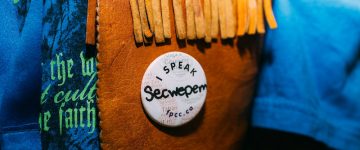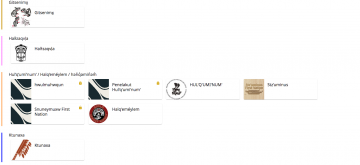The First Peoples’ Cultural Council (FPCC) provides leadership to strengthen and rebuild systems disrupted by cultural genocide through the revitalization of Indigenous languages, arts and cultural heritage. FPCC is a provincial Crown Corporation formed by the government of British Columbia in 1990 to administer the First Peoples’ Heritage, Language and Culture Program. As Indigenous cultural heritage and the living expression of Indigenous identities are integral to the health of all members of Indigenous communities, their mandate is to assist B.C. First Nations in their efforts to revitalize their languages, arts and cultures. This week in the mentoring circle, we will review two wonderful resources the FPCC has created.
FPCC is committed to providing Indigenous communities with a high level of support and quality resources. They partnered with Indigenous communities to create FirstVoices, a free online environment that connects the knowledge carried by Indigenous languages to digital technology. This community-led platform supports collaboration with Elders. Language teams can upload dictionaries, alphabets, songs, stories, words and phrases as well as audio and video to their community sites. FirstVoices is an online space for Indigenous communities to share and promote their language, oral culture and linguistic history with community members and the broader public. FirstVoices provides technology, training and technical support to Indigenous community language champions.
Languages are the key to our cultures. FirstVoices is a suite of web-based tools and services designed to support Indigenous people engaged in language archiving, language teaching and culture revitalization. FirstVoices provides a set of open-source software designed to record and promote Indigenous oral culture and revitalize the linguistic history of Indigenous peoples. As an initiative of the First Peoples’ Cultural Council, their goal is to help Indigenous languages succeed and promote diversity of Indigenous languages and cultures. Importantly, Indigenous nations retain ownership of content created by them for use on their community site. Head to FirstVoices and download their apps to start your learning journey.
In addition to the online platform, FirstVoices also includes games, mobile apps and keyboards:
- FirstVoices Dictionary Apps: Interactive dictionary/phrase app in First Nations languages for Android and iOS. The apps are free to download and contain dictionary data that is available offline in addition to audio, video and images. Users can bookmark favourite words, practice with flashcards and browse words/phrases from a variety of subjects and categories.
- FirstVoices Keyboard App: Contains keyboard software for First Nations languages. Once the FirstVoices Keyboard app is installed on a mobile device, users then are able to select their keyboard(s) of choice within their email, social media, word processing or other apps. FirstVoices keyboards are an important tool for recording and revitalizing languages. Based on Keyman technology, the FirstVoices Keyboards app includes support for 100+ First Nations languages in B.C., Canada and around the world.
- Educational Games For Kids: Data uploaded to FirstVoices powers auto-generated games and an interface designed specifically for kids. A set of interactive online games providing pre-readers with access to language resources are also available.
The First Peoples’ Map was created by First Peoples’ Cultural Council in collaboration with First Nations communities and Indigenous artists, language champions, Elders, Knowledge Keepers and cultural workers. The content is created and contributed by these community experts with the support of FPCC staff. First Peoples’ Map of B.C. can be used to view Indigenous language regions, artists and artworks, place names and community landmarks. You can hear the pronunciation of language names, greetings, places and more. All of the 34 languages Indigenous to what is now called British Columbia are represented. The language map was started by linguist Sarah Kell with contemporary language group boundaries provided by the Museum of Anthropology here at the University of British Columbia. In 2012, the First Peoples’ Arts Map was created to provide an online space where Indigenous artists, groups and organizations can put themselves on the map and gain visibility for their practices as visual artists, performers, musicians, storytellers, and media artists. The map has been updated, modernized, and merged with language and heritage on the First Peoples’ Map of B.C. and remains rooted in Indigenous communities who contribute all of the content.

